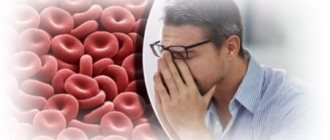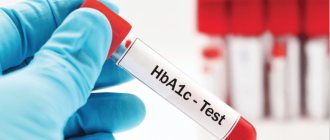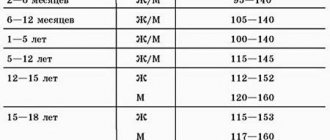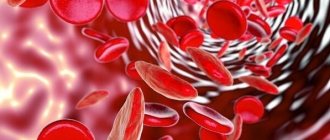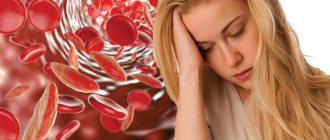Ferritin: what is it?
Ferritin is a complex complex of proteins that plays the role of a battery of iron molecules. From the Latin name of the chemical element iron (ferrum, Fe) comes the name of the iron-containing protein complex - ferritin. It is ferritin that supplies iron to every cell that needs it.
The human body does not synthesize iron itself. This element comes to us with food. The level of iron absorbed directly depends on age. The younger a person is, the higher his ability to isolate this element from food and store it in the form of ferritin. Children in the first year of life can absorb the maximum amount of iron – up to 70% of the amount consumed. By the age of 10 years, the body shaves 7 times less of the incoming volume. Adults receive only 10% of the iron they eat per day.
The chemical processes of a healthy person’s body clearly control the amount of iron in the blood and, if necessary, adjust the distribution of the resulting volume of elements. For example, with a sufficient amount of iron in the body, the absorbed part of it can be set aside as a kind of preparation “for a rainy day” - this is ferritin, which, when the first need arises, will deliver iron in the required volume to the organ in need. And with a reduced concentration of iron in the body, ferritin does not replenish its reserves, since the entire absorbed volume is immediately distributed throughout the tissues.
Ferritin is located in the liver, plasma, bone marrow, placenta and spleen. The level of total ferritin in the body is determined by studying the composition of blood plasma.
Laboratory diagnosis of anemia
Various indicators in the analysis may indicate iron deficiency in the body, but a diagnosis of anemia can only be made through a set of laboratory tests.
Usually, if anemia is suspected, the patient is prescribed general and biochemical blood tests, where the main indicators are:
Serum iron
– this indicator reflects the amount of iron in the bloodstream, the reserve level of iron reserves in tissues;
Ferritin
– biomarker of iron deficiency conditions. The protein ferritin accumulates iron reserves that were not used by red blood cells. The level of this reserve is very important to know, since depletion of reserves gradually leads to the development of anemia. The good news is that the decrease in ferritin occurs gradually and early diagnosis of a person will prevent the progression of anemia;
Transferrin
– will indicate iron metabolism, the cause and type of developing anemia;
Vitamin B12
– will help determine whether iron from food is absorbed. Long-term B12 deficiency is dangerous, since the vitamin is necessary for the formation of blood cells and the proper functioning of the nervous system;
Total iron binding capacity of serum (TIBC)
– determines the amount of iron in the body and its relationship with other proteins. TIHR is considered a stable indicator that indicates the circulation of iron regardless of nutrition during the day (iron levels change during the day, so it is important to correctly interpret the overall “picture” in the body);
Hemoglobin and red blood cell levels
– the average amount of hemoglobin in red blood cells. Changes in these indicators are the first “bells” for the patient and doctor about pathological changes in the body.
Depending on the general condition and complaints of the patient, the doctor may prescribe individual blood tests or a whole range of tests.
“Symptoms of anemia are often mistaken for chronic fatigue or overwork, but it is important to be on the alert: identify it and begin treatment. Ferritin is the most important indicator in diagnosing anemia,” comments LabQuest laboratory diagnostics expert Yulia Sergeevna Latynina.
Ferritin: normal levels
Various diseases or certain physiological processes can affect ferritin levels. Natural reasons for decreased performance include:
- periodic female bleeding;
- pregnancy;
- dieting.
To monitor health status as a preventive measure, as well as in case of symptoms typical of iron deficiency, a biochemical blood test for ferritin is performed. The collected biomaterial is examined to understand how many micrograms of iron are contained in one liter of plasma.
The norms for each age group are different:
- in newborns from 25 to 600 mcg/l;
- in children older than 28 days, but not yet 9 weeks of age, the norm is 20-600 mcg/l;
- in children from 2 to 5 months it should be from 50 to 200 mcg/l;
- children aged from six months to one year should have from 70 to 140 mcg/l;
- girls and women over 12 years of age should have a normal level of 22 to 180 mcg/l;
- boys and men over 12 years old - from 30 to 310 mcg/l.
Women's blood contains less ferritin because it contains less hemoglobin, red blood cells and iron molecules. In addition, pregnancy makes its own adjustments to ferritin levels:
- in the first trimester of pregnancy, levels can reach 90 mcg/l;
- in the second trimester, blood contains up to 74 mcg/l;
- and the third trimester is famous for its low ferritin level - only 10-15 mcg/l.
Ferritin is a protein in which iron is stored in tissues.
Synonyms Russian
Deposited iron, metalloprotein, indicator of iron reserves.
English synonyms
Ferritin.
Research method
Immunoturbidimetry.
Units
μg/L (micrograms per liter).
What biomaterial can be used for research?
Venous blood.
How to properly prepare for research?
- Do not eat for 8 hours before the test; you can drink clean still water.
- Stop taking medications containing iron 72 hours before the test.
- Avoid physical and emotional stress and do not smoke for 30 minutes before the test.
General information about the study
Ferritin is a protein in the form in which iron is mainly stored in the body.
It is absorbed from food and then transferred by transferrin, a special protein that is formed in the liver. Iron is necessary for the formation of red blood cells and is an essential part of hemoglobin, a protein that fills red blood cells and allows them to carry oxygen from the lungs to organs and tissues. In addition, it is part of the muscle protein myoglobin and some enzymes.
Normally, the body contains 4-5 grams of iron. About 70% of this amount is iron, “built-in” into the hemoglobin of red blood cells. The remainder is mainly stored in tissues as part of protein complexes - ferritin and hemosiderin - which are mainly found in the liver, as well as in the bone marrow, spleen and muscles. Although ferritin is present in small amounts in the blood, its concentration reflects the body's iron stores.
When iron begins to be scarce, for example, in the case of reduced intake of it with food or frequent bleeding, the body begins to use reserves from tissues. The amount of ferritin decreases accordingly. A long-term lack of iron intake can lead to anemia. Ferritin levels can be reduced long before the symptoms of iron deficiency appear and allow anemia to be diagnosed in time.
On the other hand, if too much iron is taken in, it can lead to excessive iron accumulation and, as a result, damage to the liver, heart and pancreas.
It is worth noting that the use of various tests that reflect iron metabolism in the body provides more complete and reliable information about the deficiency or excess of this microelement than just a ferritin test.
What is the research used for?
- To assess iron reserves in the body. This is necessary to identify iron deficiency or excess.
- To determine whether anemia is caused by a lack of iron or other causes, such as a chronic illness or lack of vitamin B12.
When is the study scheduled?
- If abnormalities are detected in tests such as general blood count, hemoglobin, hematocrit, red blood cell count.
- If you suspect a deficiency or excess of iron in the body.
In the early stages, iron deficiency may be asymptomatic. If a person is otherwise healthy, then signs of the disease sometimes appear only when hemoglobin drops below 100 g/l. The development of anemia is indicated by the following complaints: chronic weakness/fatigue, dizziness, headaches.
With severe anemia, the patient may suffer from shortness of breath, chest pain, severe headaches, and weakness in the legs. Children have learning difficulties.
In addition to the main ones, there are several more signs characteristic of iron deficiency: the desire to eat unusual foods (chalk, clay), burning of the tip of the tongue, jams - cracks in the corners of the mouth.
- If you suspect iron overload (hemochromatosis). This condition can manifest itself in different ways, for example, pain in the joints, abdominal pain, weakness, fatigue, decreased sexual desire, and irregular heart rhythm.
- When monitoring the effectiveness of treatment of anemia and conditions accompanied by iron overload.
What do the results mean?
Reference values
| Age | Reference values |
| 1-2 months | 200 - 600 µg/l |
| 2-5 months | 50 - 200 µg/l |
| 5 months – 15 years | 7 - 140 µg/l |
| Men over 15 years old | 20 - 250 µg/l |
| Women over 15 years old | 10 - 120 µg/l |
Reasons for low ferritin levels
- Iron deficiency, including hidden. A decrease in ferritin below 10 ng/ml usually indicates iron deficiency anemia.
- Third trimester of pregnancy. A decrease in the amount of iron in this case is normal.
Causes of increased ferritin levels
- Hereditary hemochromatosis. In this disease, too much iron is absorbed from food and deposited in various organs, causing them to become damaged.
- Multiple blood transfusions, intramuscular iron administration, administration of iron tablets.
- Inflammations, such as upper respiratory tract infections, urinary tract infections, autoimmune diseases. Moreover, an increase in ferritin in the acute phase of inflammation can mask the existing iron deficiency.
- Acute or chronic liver diseases.
- Alcoholism.
- Hemolytic anemia: associated with the destruction of red blood cells, B12 deficiency anemia, thalassemia.
- Hyperthyroidism – increased function of the thyroid gland.
- Oncological diseases of the bone marrow, breast cancer, Hodgkin's disease - a malignant neoplasm of lymphoid tissue. Ferritin levels will increase significantly.
What can influence the result?
- Falsely increased results can be caused by: fasting,
- alcohol, estrogens, oral contraceptives, iron supplements.
Why is low ferritin dangerous?
A decrease in ferritin levels is primarily an indication for analysis of the nutritional system. Most often, insufficient iron levels in the blood are caused by improper diets or fasting. The second most popular cause is bleeding and diseases of the digestive system. With blood loss, large volumes of iron leave the body, and due to impaired absorption function, the deficiency cannot be replenished.
With a lack of ferritin, the following symptoms appear:
- brittle nails;
- hair loss;
- decreased libido;
- mood swings;
- increased heart rate;
- dizziness;
- memory impairment.
Low ferritin, if not detected in time, and nutrition adjustments and the necessary treatment are not started, can become an impetus for the development of iron deficiency anemia.
Iron deficiency anemia - symptoms and treatment
Treatment is carried out with iron-containing preparations, mainly for oral administration and much less often for intramuscular or intravenous administration. The drugs should not be taken without a doctor’s prescription, since an excess of iron is dangerous due to its consequences - dental damage, the development of hepatitis, liver cirrhosis, diabetes and cardiovascular diseases. Severe allergic reactions are also possible.
If you have anemia, you should change your diet and include foods that contain iron in the most digestible form - veal, beef, lamb, rabbit meat, liver, tongue. It is important to remember that up to 30% of iron is absorbed from meat, 10% from fish, and only 3-5% from plant foods.
In case of anemia, correction of iron deficiency cannot be achieved by dietary changes alone. The reason for this is that the absorption of iron from food is limited, and in preparations it is contained in higher concentrations.
When treating patients with IDA, it is necessary to take into account the nature of the underlying disease and the presence of concomitant pathology, the age of the patients (children, old people), the severity of anemic syndrome and iron deficiency, tolerability of iron supplements, etc. [3].
For mild to moderate anemia, it is better to take iron supplements orally along with ascorbic or folic acid , as they improve the absorption of iron.
Within two hours before or after taking iron supplements, it is not recommended to drink coffee and caffeine-containing drinks (cocoa, chocolate, tea), cereals (rye, barley, oats, wheat), nuts, legumes, milk, eggs and dairy products, fatty and flour products, as well as some medications and vitamins containing calcium, magnesium, zinc, selenium, iodine, chromium. This will help avoid deterioration in iron absorption. All iron supplements are prescribed by a doctor individually. The course of treatment is at least 1.5-2 months, possibly longer. In addition to restoring the level of iron in the blood, you need to create its reserve in the body, that is, increase the level of ferritin. The success of treatment is indicated by normalization of hemoglobin levels after 1-2 months [9][10].
If iron preparations cannot be taken orally (for example, in case of intolerance or impaired absorption of iron in the intestine), then they are administered intramuscularly or intravenously. Injectable iron preparations are used only in hospitals, as they can cause shock reactions. They cannot be used during pregnancy and lactation.
, red blood cell transfusion is performed in a hospital setting
Hematogen can be used as a therapeutic and prophylactic agent for patients who do not have diabetes mellitus. It contains iron, which binds proteins obtained from the blood of cattle, as well as ascorbic acid and the necessary protein complex. However, this is a fairly high-calorie product - 100 g of hematogen contains 350-500 kilocalories, this should be remembered when including it in the diet.
High ferritin levels
High ferritin, close to the normal limit, indicates that tissues and organs receive a sufficient amount of iron every day from the diet, thanks to which the body is able to store reserves of an important element. If the values obtained as a result of laboratory tests gave inflated indicators, significantly beyond the acceptable limits, this is a reason to examine to identify:
- oncology;
- infection with the immunodeficiency virus;
- problems in the functioning of the endocrine system.
Separately, you need to analyze your diet. Perhaps excess iron can easily be explained by a diet rich in this element.
Anemia: what is ferritin and what is it eaten with?
Currently, according to various sources, the prevalence of iron deficiency anemia (hereinafter referred to as IDA) varies from 5% to 40% among the adult population, and among pregnant women it reaches 50%. In the usual sense, the diagnosis of IDA is based on a general blood test, which shows a decrease in hemoglobin, as well as symptoms such as dry skin, fatigue, brittle nails, perversion of taste, and pale skin. However, today it is of great importance not only to determine the decrease in hemoglobin in the blood, but also other indicators involved in iron metabolism, the most important of which is ferritin.
Ferritin is a protein that reflects the level of iron reserves in the body. It is highly specific in diagnosing anemia. When symptoms are severe and hemoglobin is low, this indicator is necessary to separate iron deficiency anemia from the anemia of chronic diseases, the treatment of which may vary depending on the cause. With iron deficiency anemia, there is a decrease in ferritin, the norm of which is 40-60 mcg/l for both adults and children, but the norm is often calculated individually, based on weight.
In addition to clinically pronounced IDA with a decrease in hemoglobin, there is such a thing as latent iron deficiency, which cannot be diagnosed using a general blood test. Ferritin is the most indicative for diagnosing hidden iron deficiency. The question arises: “Why is it necessary to diagnose latent iron deficiency in principle if there are no manifestations of anemia?” Diagnosis of latent iron deficiency in the blood before the onset of symptoms is necessary for people at risk for further prevention.
Risk groups for IDA include:
- women with heavy menstruation;
- pregnant women;
- blood donors;
- people with constant chronic blood loss (gastric, hemorrhoidal, nosebleeds, intestinal bleeding);
- people with diseases leading to impaired iron absorption (mainly inflammatory bowel diseases);
- premature babies;
- people on a special diet due to personal beliefs (vegetarian and vegan diets);
- people who constantly take painkillers from the group of non-steroidal anti-inflammatory drugs.
These groups of people are recommended to take a complete blood count, serum iron and ferritin at least once a year, with the exception of pregnant women who need monitoring during pregnancy and the postpartum period.
In addition to its reserve function, ferritin is an acute phase protein, that is, a protein released during acute inflammatory diseases, as well as during the breakdown of one’s own tissues, for example, during cancer. In this regard, normal or increased levels of ferritin may be observed in case of iron deficiency, therefore, in such conditions it is not recommended to focus on this indicator. Also, sometimes when diagnosing iron deficiency, a normal serum iron level with a decreased ferritin level may be observed. In such situations, the determining factor is the ferritin level, since the iron level can be subject to strong fluctuations and does not always reflect the real picture, unlike the ferritin level.
If latent iron deficiency or IDA is detected, the doctor prescribes iron supplements depending on the severity. It is incorrect to believe that iron deficiency can be compensated only by diet therapy, that is, by increasing food intake containing a high content of Fe2+, since there is a maximum amount of iron absorption per day from foods (a person is not able to consume the amount of food that is necessary to restore normal iron levels) .
Thus, the diagnosis of anemia is not limited to just a general blood test. The decision to prescribe iron metabolism indicators is made by the doctor, including which indicators are needed at the moment. It is also necessary to remember that it is impossible to choose the right treatment on your own, without guidance from a doctor, and this can often be dangerous. Therefore, if you are at risk or notice symptoms of anemia, consult your doctor.
Making an appointment with a general practitioner
To clarify the details, consult a qualified specialist at the Semeynaya clinic.
Single contact center
8 495 662-58-85
weekdays 8-21, weekends 9-21
To find out more about prices for seeing a therapist or other questions, please follow the link below:
Therapy
Iron and iron health: what role does the microelement play in our body?
Iron is part of hemoglobin. In turn, the protein hemoglobin is a building material for erythrocytes - red blood cells that carry oxygen from the lungs to the organs, and on the way back rid them of carbon dioxide. Actually, this process is called cellular respiration. Without iron it is impossible. And since every cell in our body needs oxygen, iron can be called one of the most important elements.
The synthesis of hemoglobin takes 60–70% of all iron entering the body. The remaining 30–40% is deposited in tissues and spent on solving other problems - metabolic processes, regulation of the thyroid gland, maintaining the body's defense system and connective tissue synthesis.
As you can see, the functions of iron are varied and numerous, but oxygen transport is the most important of them.
Iron is poorly absorbed even with ideal health and proper diet - the human body is able to absorb up to 10% of the iron supplied with food.
